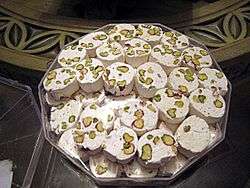Gaz (candy)
|
Persian gaz candy | |
| Type | Confectionery (nougat) |
|---|---|
| Place of origin | Iran |
| Region or state | Boldaji |
| Main ingredients | Gaz of Khunsar or sugar or corn syrup, pistachio or almond kernels, rosewater, egg whites |
|
| |
Gaz (Persian: گز) is a Persian nougat from the Boldaji region.
The name gaz is associated with gaz-angebin which translates to 'sap of angebin', in reference to a species of Tamarisk, T. gallica[1] that is native to the Zagros mountain range located to the west of the Esfahan and Boldaji.
The sweet, milky sap (gaz of Khunsar) found on the angebin plant is associated with manna, a food mentioned in the religious texts of the Abrahamic religions. The sticky white substance is formed from honeydew, which is exuded from the anus of the nymph of a psyllid insect, either Cyamophila astragalicola[2] or C. dicora,[3] in its final instar, which live on plants of Astragalus adscendens,[2] and is collected annually and is combined with other ingredients including pistachio or almond kernels, rosewater and egg white. Modern versions of gaz may not contain gaz of Khunsar and may use sugar and corn syrup as substitutes for psyllid manna.[4][5]
The traditional way to serve gaz is in round pieces that are about 2 inches in diameter and up to 1/2-inch thick. A modern presentation is to serve the nougat cut into smaller rectangles.[6] Depending on the ingredients mixed in, gaz can have a subtle rose flavor, a nutty taste, or a savory and pungent profile. It can be white, or it can become another color because of the addition of spices (such as saffron) or nuts.[6]
Celebrations such as Nowruz, the Persian New Year, feature gaz.[6] During the Nowruz holiday, family and friends visit each other's homes and, typically, the host offers fruits and sweets to their guests. Served with sherbet or tea, gaz is a favorite delicacy and a much-appreciated gift as it helps to ensure that a household will have ample snacks to serve all holiday visitors.[6]
See also
References
- ↑ Wulff, Hans, M.I.T. Press, 1966, The traditional crafts of Persia: their development, technology, and influence on Eastern and Western civilizations
- 1 2 Grami, Bahram (1998). "Gaz of Khunsar: The manna of persia". Economic Botany. 52 (2): 183–191. doi:10.1007/BF02861207. Retrieved 2012-01-04.
- ↑ "Gaz(1)". Encyclopædia Iranica. 2000. Retrieved 2012-01-04.
- ↑ http://candy.about.com/od/nougatcandyrecipes/r/persian_nougat.htm
- ↑ http://www.ciaosamin.com/2011/09/gaz-persian-nougat.html
- 1 2 3 4 "Heavenly Persian Nougat – Candy Atlas". Candy Atlas. Retrieved 2015-10-29.
